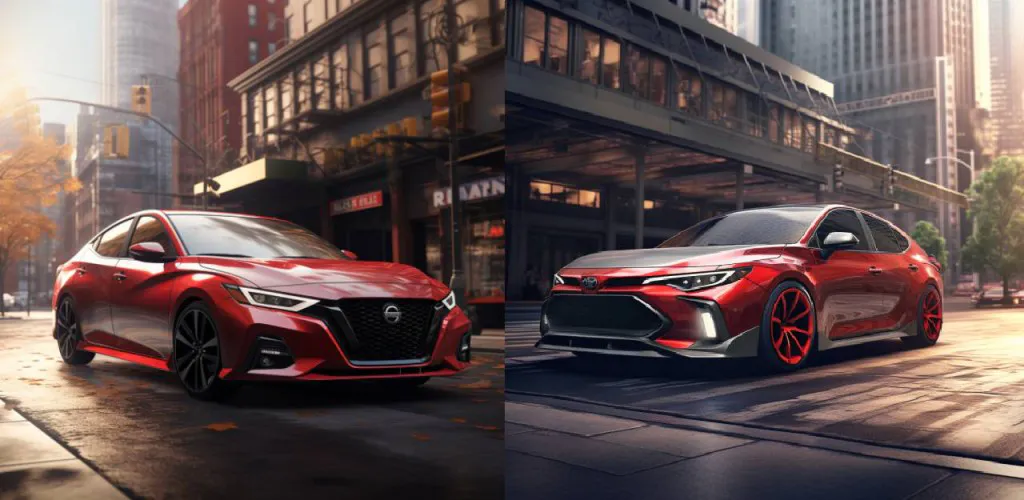Not too long ago, car buyers could find a compact sedan from just about every mainstream automaker. However, American manufacturers abandoned this segment to pursue SUVs and more profits. The result? Fewer entry-level new passenger cars on the market.
Among the models still available are the 2023 Nissan Sentra and the 2023 Toyota Corolla. These vehicles compete with the Honda Civic, Hyundai Elantra, Kia Forte, Mazda Mazda3, and Volkswagen Jetta.
The Sentra isn’t quite the cheapest Nissan (the Versa is), but at $20,000, it’s one of the most affordable new vehicles. Entry level for Toyota means shopping for a Corolla, which starts at $22,000. With more than 50 million sold, the Corolla is not only the world’s most popular car but arguably the standard bearer for its class (you can also make a case for the Civic).
I’ve never owned a Sentra or Corolla, but I’ve spent enough time driving them as rental and loaner cars to understand what they do and don’t offer. In short, these cars provide functional transportation that won’t break the bank.
A few years back, Nissan and Toyota decided to improve the looks of their wallet-friendly offerings. The once-plain Corolla now has a sleeker exterior. It’s not a head-turner, but it can no longer be accused of being as exciting as a washing machine. Meanwhile, the Sentra transformed from an ugly duckling to a stylish swan with the launch of the eighth generation for the 2020 model year.
Thanks to all these improvements, these two compacts are as competitive as ever. True to form, the Sentra costs less than a comparable Corolla. In addition, Nissan has added advanced safety technologies that are optional or unavailable on this Toyota, further adding to the Sentra’s value. This Nissan also features a larger cabin.
The Corolla holds its own against the Sentra. A more powerful engine helps with quickness while delivering better fuel economy. In addition, lower depreciation and reduced maintenance expenses lead to a less expensive ownership experience. Plus, the Sentra can’t match the Corolla’s options for hybrid power, all-wheel drive, and a hatchback body style.
Keep reading to learn how the 2023 Sentra and Corolla compare. There’s no clear winner, but individual factors like price and features may help you decide one over the other.
Curious about how older Sentra and Corolla models stack up? Read: Nissan Sentra vs. Toyota Corolla | The Best Model Year For Every Budget.
Learn more about the methodology used for this article.
2023 Nissan Sentra vs. Toyota Corolla | A Guide to Trim Levels & Optional Features
Trim Levels: Starting Prices
Quick Take: The Nissan Sentra consistently offers more value than the Corolla, but only Toyota offers hybrid and hatchback versions.
While Nissan is no small operation, it pales compared to Toyota, the world’s largest automaker. Nissan maintains sales against this giant competitor by keeping its offerings simple and undercutting prices.
By swelling three Sentra trims (the Sentra SR Midnight is technically a fourth trim but is more of an appearance package added to the SR edition), Nissan keeps its costs in check. Toyota also relies on three core sedan trims (LE, SE, and XSE) but adds an upscale XLE trim for the hybrid. Throw in all the hybrid and hatchback versions, and there are nine Corolla variants to choose from. Toyota believes in a “something for everyone” philosophy.
From a purely bottom-line perspective, the base Sentra S ($20,200) offers a $1,500 savings over the least expensive Corolla (the LE at $21,700). This gap may seem insignificant, but stepping up to this Corolla means shelling out 7% more. Every dollar often counts for shoppers in this category.
The Sentra SV’s standard equipment doesn’t quite align with the Corolla LE. However, for an extra $280, Nissan buyers get proximity keyless entry, alloy wheels, and other goodies. Equally important, Nissan lets SV buyers add option packages with upscale features like heated front seats and dual-zone automatic climate control, equipment not even optional on the cheapest Corolla.
The Sentra’s greater value proposition becomes more prominent as one moves up to the SR trim. Frankly, Nissan packs a lot of standard equipment for $23,090, like dual-zone automatic climate control, remote start, LED fog lights, 18-inch black-finish alloys, upgraded seats, and “sporty” exterior treatments.
In many ways, the Sentra SV slots between the Corolla SE ($24,140) and XSE ($26,850) in terms of included equipment and sporty touches. Those considering the Corolla XSE can save a whopping $3,760 by choosing the Sentra SR. That’s serious money in this category and about a $75 per month difference in the monthly payment on a five-year loan at 7%.
Of course, if your compact car preference leans towards a hatchback or hybrid, there’s no reason to visit a Nissan showroom. Only the Corolla offers these variants. Just keep in mind that the entry price for the least expensive Corolla Hybrid (the LE sedan) is $2,850 more than the Sentra S.
Cost of Ownership
Quick Take: The Toyota Corolla is modestly cheaper to keep on the road than the Nissan Sentra.
Looking beyond bottom-line pricing and examining long-term ownership costs is the smart way to shop for a new car.
Edmunds projects that a 2023 Sentra will incur $36,812 in costs over five years (based on 15,000 miles of annual use per), which works out to $0.49 per mile. Meanwhile, the 2023 Corolla’s tally is $35,263, or $0.47 per mile. Simply put, the Corolla is cheaper to own by $309 per year.
I would have expected the Corolla’s lower depreciation and reduced maintenance bills to have a more substantial impact. But, the Sentra’s lower starting price still matters.
| 5-Year Ownership Cost | ||
| Costs | Nissan Sentra | Toyota Corolla |
| Trim | S | LE |
| Cost to Own | $36,812 | $35,263 |
| Average Cost Per Mile | $0.49 | $0.47 |
| Depreciation | $10,798 | $10,333 |
| Fuel | $7,826 | $7,380 |
| Maintenance | $4,754 | $3,668 |
| Repairs | $631 | $631 |
2023 | Nissan Sentra vs. Toyota Corolla | Specifications | Safety, Interior, and Exterior Features
Sizing up the Nissan Sentra and Toyota Corolla involves examining each vehicle’s specifications. Here’s what you need to know.
Vehicle Class & Body Style:
Quick Take: The Sentra and Corolla are classified as midsize cars.
The Sentra and Corolla compete for the same buyers, which makes sense as the U.S. Environmental Protection Agency (EPA) categorizes both vehicles as midsized. But the Sentra has a greater passenger volume. Later, I’ll examine how the difference affects interior dimensions.
| 2023 Nissan Sentra | 2023 Toyota Corolla | |
| Class | Midsize Sedan | Midsize Sedan/Hatchback |
| 4-Door Sedan | S, SV, SR, SR Midnight Edition | LE, SE, XSE, LE Hybrid, SE Hybrid, SE Infrared Edition Hybrid, XLE Hybrid |
| 5-Door Hatchback | N/A | SE Hatchback, XSE Hatchback |
Powertrain
Quick Take: Toyota makes better use of a 2.0-liter engine, giving the Corolla quicker acceleration and greater fuel economy. The Corolla Hybrid is available with all-wheel drive.
Engine Options & Specifications:
No one thinks of the Toyota Corolla as a performance car (the hot hatch GR Corolla is another matter and not part of this conversation), but it’s a barn burner compared to the plodding Sentra.
Both cars rely on a 2.0-liter four-cylinder engine, but the contrast in specifications and performance is eye-opening. The Sentra slowly chugs along with 149 horsepower and a zero to 60 mph time of 9.2 seconds. In the meantime, the 169-horsepower Corolla requires 8.2 seconds for the same task. This one-second difference can matter, especially while using highway on-ramps.
The Corolla Hybrid drops to Sentra-level performance because Toyota prioritizes fuel economy over acceleration. Its smaller 1.8-liter four-cylinder engine produces a modest 138 horsepower, explaining the 9.0-second 0-60 time (which still beats the Sentra).
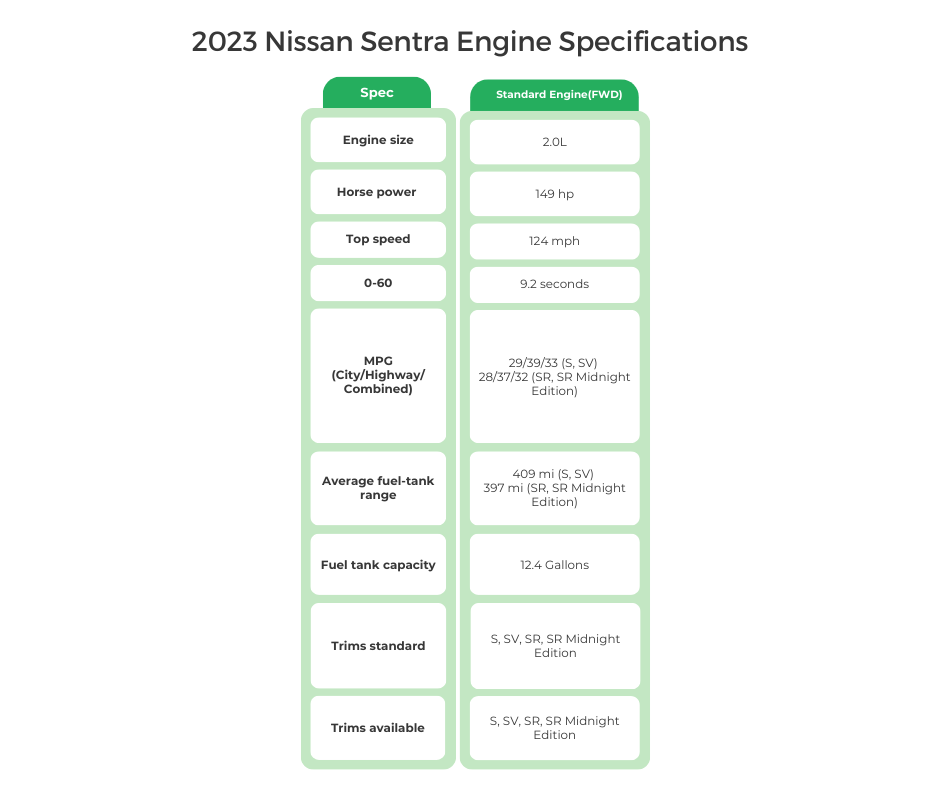
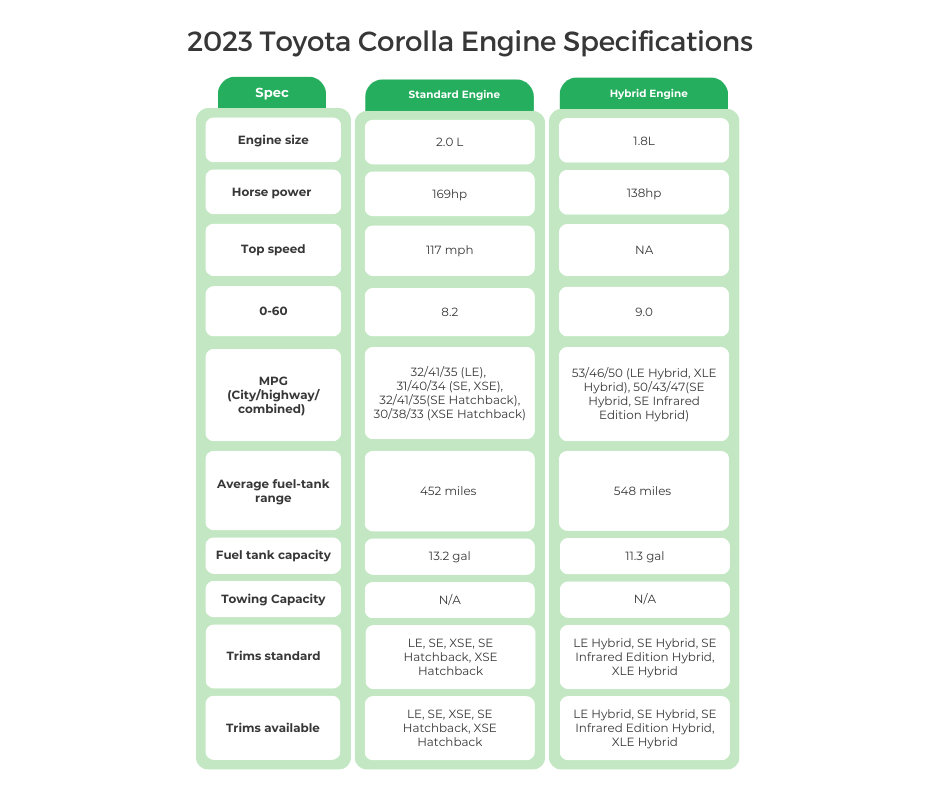
Fuel Economy:
Focusing on sedans (the only Sentra body style) shows that a non-hybrid Corolla delivers about 5%-10% better fuel economy than the Sentra. For example, the base Sentra S is EPA-rated at 29 mpg in the city and 39 mpg on the highway, respectable numbers for a conventionally powered small car. Yet, the quicker and more powerful Corolla LE is estimated to deliver 32 mpg around town and 41 mpg on the open road.
In real terms, this only equals $90 in annual fuel savings for the Corolla (based on Edmunds’ ownership cost projections). Few people will likely select the Corolla over the Sentra for this one factor.
Yet, put a Corolla Hybrid in the mix, and fuel economy substantially increases. A Corolla Hybrid LE is rated at 53 mpg (city) and 46 mpg (highway), translating into $533 lower annual fuel costs than the base Sentra. You’ll need about five years of reduced gas use to pay for the extra cost of a Corolla Hybrid (remember the $2,850 difference I mentioned above).
Wondering about fuel economy for an older Sentra or Corolla? Check out: Nissan Sentra vs. Toyota Corolla | The Best Model Year For Every Budget.
Transmission Options & Specifications:
Discussing gearboxes for the Sentra and Corolla means talking about continuously variable transmissions (CVTs). A CVT does away with conventional gears in favor of a belt and pulley system. Automakers love CVTs because they have lower manufacturing costs and better fuel economy. The era of conventional automatic transmissions or row-your-own gears is over for these cars. See the “Tech Talk” section below the charts to learn about CVTs and eCVTs.
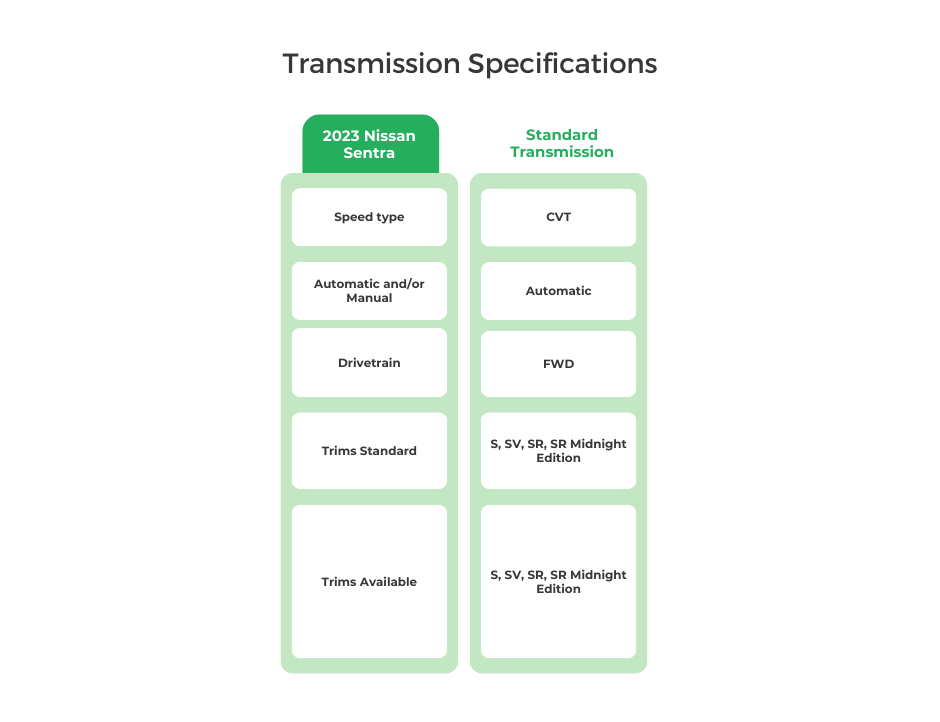
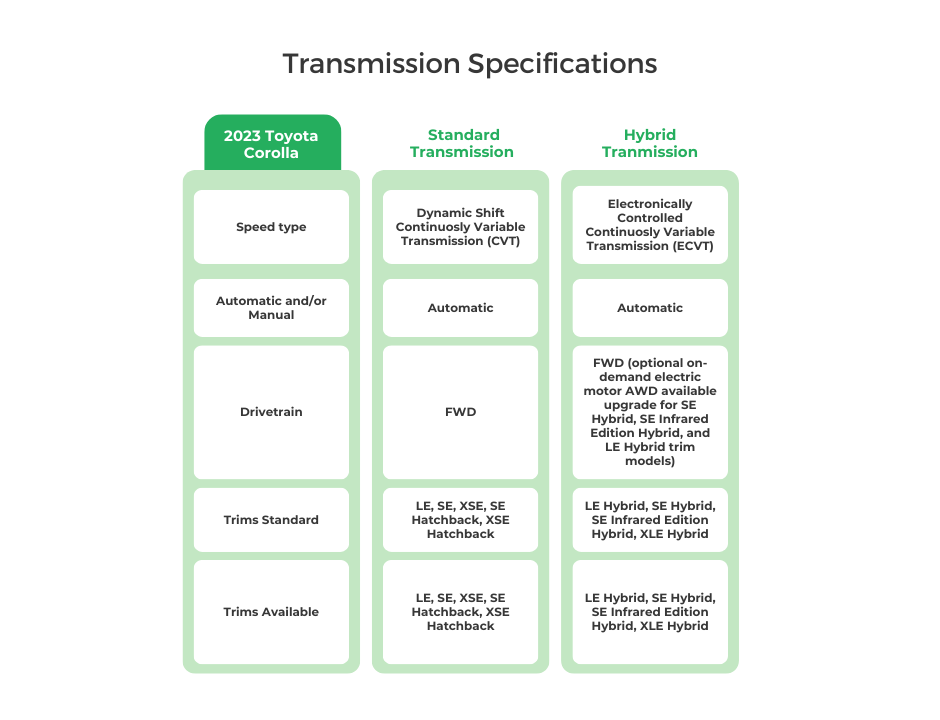
TECH TALK: CVTs
A continuously variable transmission (CVT) does not use gears like a typical automatic transmission. Instead, it has two pulleys connected by a belt. One pulley connects to the engine, and the other connects to the wheels. The belt transfers the power between the pulleys. This setup allows the pulleys to continuously change positions as needed. The CVT automatically adjusts the pulleys as required, providing smooth and efficient power delivery.
An electronic continuously variable transmission (eCVT) uses electronic controls and electric motors to vary gear ratios instead of a belt and pulley system. Unlike a regular CVT, an eCVT has no physical pulleys or belts—the gear ratio is adjusted seamlessly by controlling the speeds of electric motors and generators. This electronic control allows faster, smoother gear ratio changes compared to a traditional CVT. An eCVT also provides more flexibility, needing less space and having fewer moving parts.
Drivetrain:
You can have any drivetrain you want in the Sentra as long as it’s front-wheel drive (FWD). Most buyers will find this setup fine. However, those who want the extra confidence of all-wheel drive (AWD) or have to deal with fair amounts of snow will find that the Corolla has an advantage. The Corolla Hybrid comes standard with FWD, while AWD is optional.
Why is AWD an option only with the Corolla Hybrid? Toyota adds an electric motor to the rear axle, which gets its power from the hybrid battery.
|
2023 Nissan Sentra Wheel Drive |
FWD |
AWD |
RWD |
|
S |
S |
||
|
SV |
S |
||
|
SR |
S |
||
|
SR Midnight Edition |
S |
|
2023 Toyota Corolla Wheel Drive |
FWD |
AWD |
RWD |
|
LE |
S |
||
|
SE |
S |
||
|
XSE |
S |
||
|
Hybrid LE |
S |
E |
|
|
Hybrid SE |
S |
E |
|
|
Hybrid SE Infrared Edition |
S |
E |
|
|
Hybrid XLE |
|||
|
SE Hatchback |
S |
||
|
XSE Hatchback |
S |
S = Standard
U = Available in upgrade
E = Electronic On-Demand AWD (Electric motor in hybrid trims with on-demand AWD capabilities), available as an optional upgrade
Safety:
Quick Take: The Sentra and Corolla did well in government safety testing and received honors from IIHS.
NHTSA Safety Ratings
Crash safety is a typical concern for small car buyers. With so many large SUVs and trucks on the road, these less sizable vehicles need all the help they can get. Nissan and Toyota have done their best with the Sentra and Corolla.
Both vehicles received top (five-star) ratings from the National Highway Traffic Safety Administration (NHTSA) for overall safety performance. The Sentra drops to a still-acceptable four stars for frontal crash safety, while the Corolla gets four stars for rollover resistance. Otherwise, these cars pass with flying colors in the other assessments.
Neither car offers a significant advantage over the other in NHTSA testing. So, you’ll have to consider other factors in making a decision.

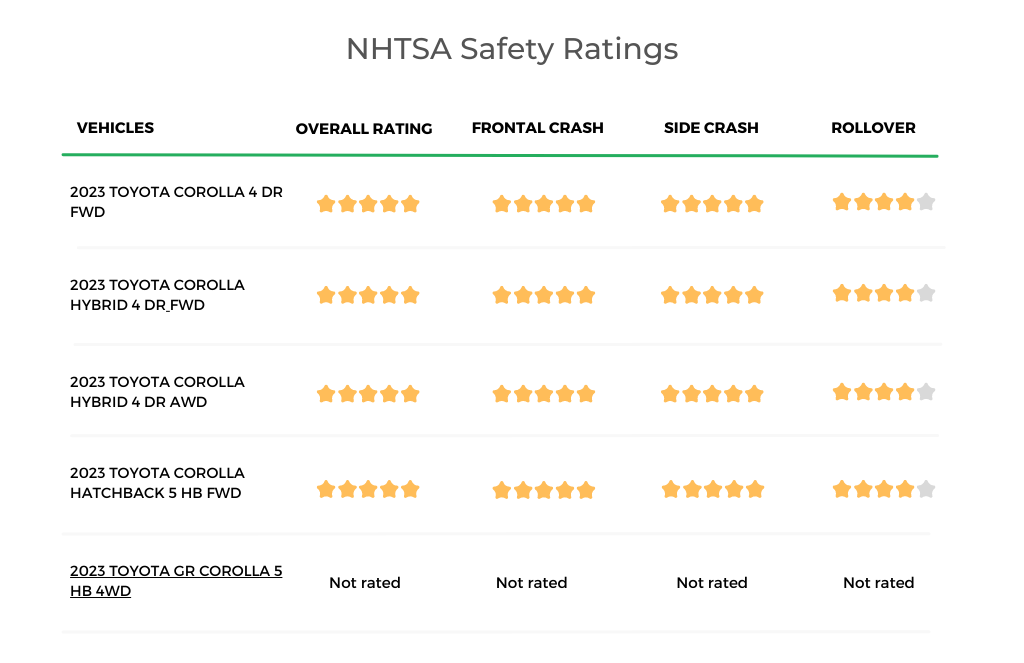
IIHS Awards:
The Insurance Institute for Highway Safety (IIHS) takes a somewhat different approach to safety testing. In particular, it focuses on its small frontal overlap crash test, which the organization feels represents a more real-world scenario (a single car running into a fixed object). IIHS also looks at side impact crashes, roof strength, headlight effectiveness, and advanced driver safety technologies (like automatic emergency braking).
While tested vehicles receive a Good, Acceptable, Marginal, or Poor grade, the true measure comes if a car gets a Top Safety Pick or Top Safety Pick+ designation. If “Good” is a “B” grade, Top Safety Pick notches things up to an “A-,” and the Top Safety Pick+ signifies an “A+.”
It’s another safety-related tie in this Sentra versus Corolla contest. Both models received IIHS Top Safety Pick awards.
| IIHS Award | Tested Vehicle | ||
| 2023 Nissan Sentra | Small Car/ 4-Door Sedan | 2022 TOP SAFETY PICK |
2020 Nissan Sentra SV 4-Door |
| 2023 Toyota Corolla | SMALL CAR/ 4-DOOR SEDAN | 2023 TOP SAFETY PICK | 2019 Toyota Corolla SE 4-door hatchback, 2022 Toyota Corolla LE 4-door sedan |
| SMALL CAR / 4-DOOR HATCHBACK | 2023 TOP SAFETY PICK | 2019 Toyota Corolla SE 4-door hatchback | |
Airbags & Head Restraints:
Despite their low price points, the Sentra and Corolla are packed with numerous airbags. The usual systems (front-row units and side curtain systems to protect both rows in a collision or rollover) are present. But Nissan and Toyota get kudos for equipping the rear outboard seats with side-mounted airbags. It’s nice to see a feature usually associated with higher-end models.
The Sentra does have one edge in the airbag department. Each front-row position has a knee airbag, which positions the body to minimize injury in a front-end accident. The Corolla only has this for the driver.
Neither the Sentra nor the Corolla comes with overhead airbags. This newer technology replaces traditional front-row units (steering wheel and dashboard) with overhead devices. Active head restraints are usually found in specialty and high-end vehicles to minimize whiplash injuries. Mainstream cars like the Sentra and Corolla aren’t usually equipped with this feature.
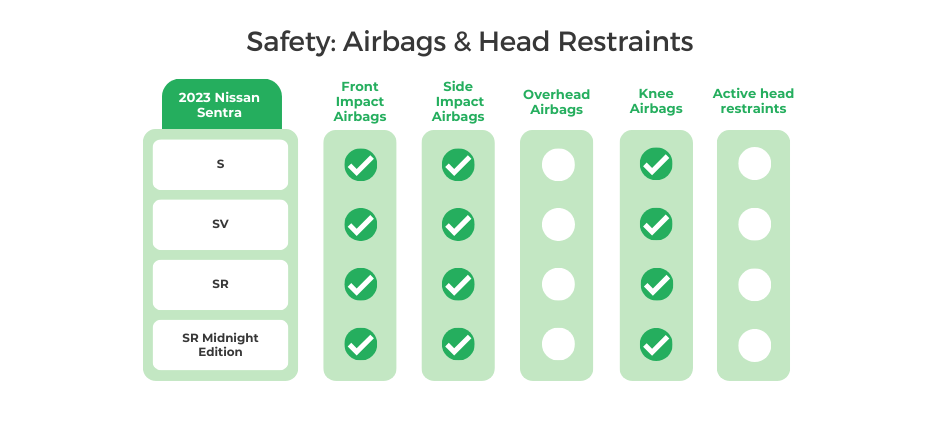
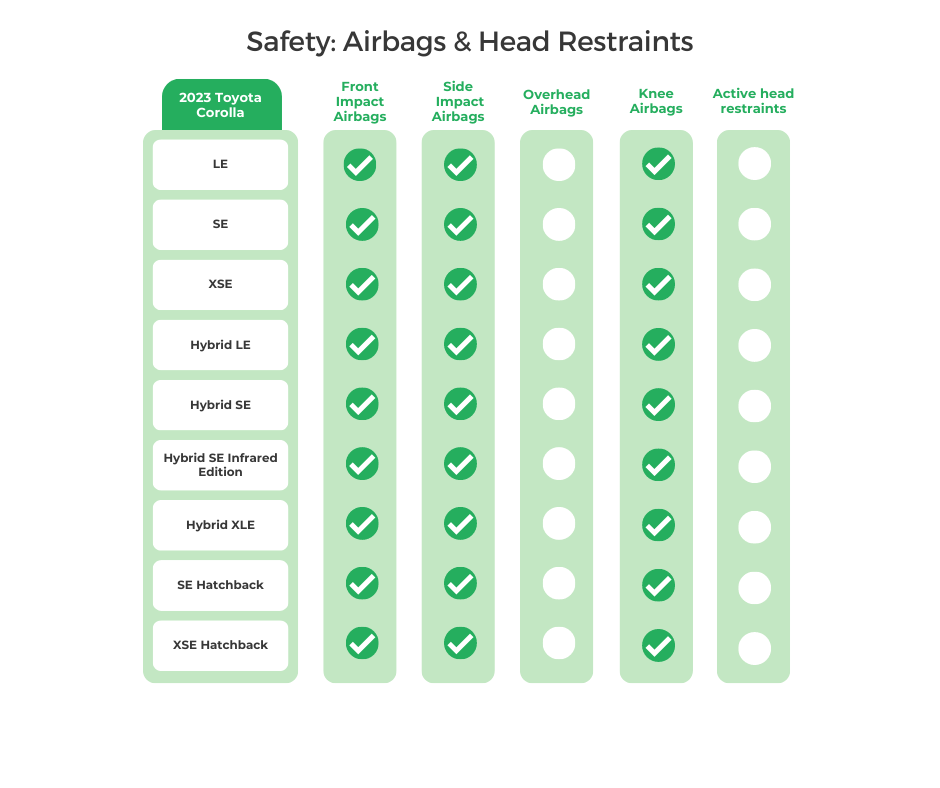
Driver-Focused Features and Equipment:
Quick Take: The Sentra includes several driver-assist technologies that are optional or unavailable on the Corolla.
Semi-Autonomous Driving:
It will be a long time before wallet-friendly cars like the Sentra and Corolla get hands-free driving systems. These technologies are usually reserved for pricier vehicles. However, the Sentra and Corolla have features that reduce the stress and danger of driving.
Both vehicles have automatic emergency braking (AEB) with pedestrian detection. A standard and lifesaving feature on most new cars (Toyota calls their version a Pre-Collision System). The Sentra also gets a nice bonus: rear automatic braking (to prevent backing into an object). This feature isn’t available on the Corolla and is uncommon in lower-end cars. Nice work, Nissan.
But the Corolla has its advantages, too. All trims get adaptive cruise control (ACC) or Dynamic Radar Cruise Control in Toyota-speak. This feature makes dealing with stop-and-go highway traffic more bearable by maintaining a proper speed and distance from the car in front. Nissan’s version, Intelligent Cruise Control, isn’t available on the base Sentra trim.
Further, all Corolla editions get continuous assistive steering to help with lane centering (when ACC is in use). The Sentra doesn’t get this technology.

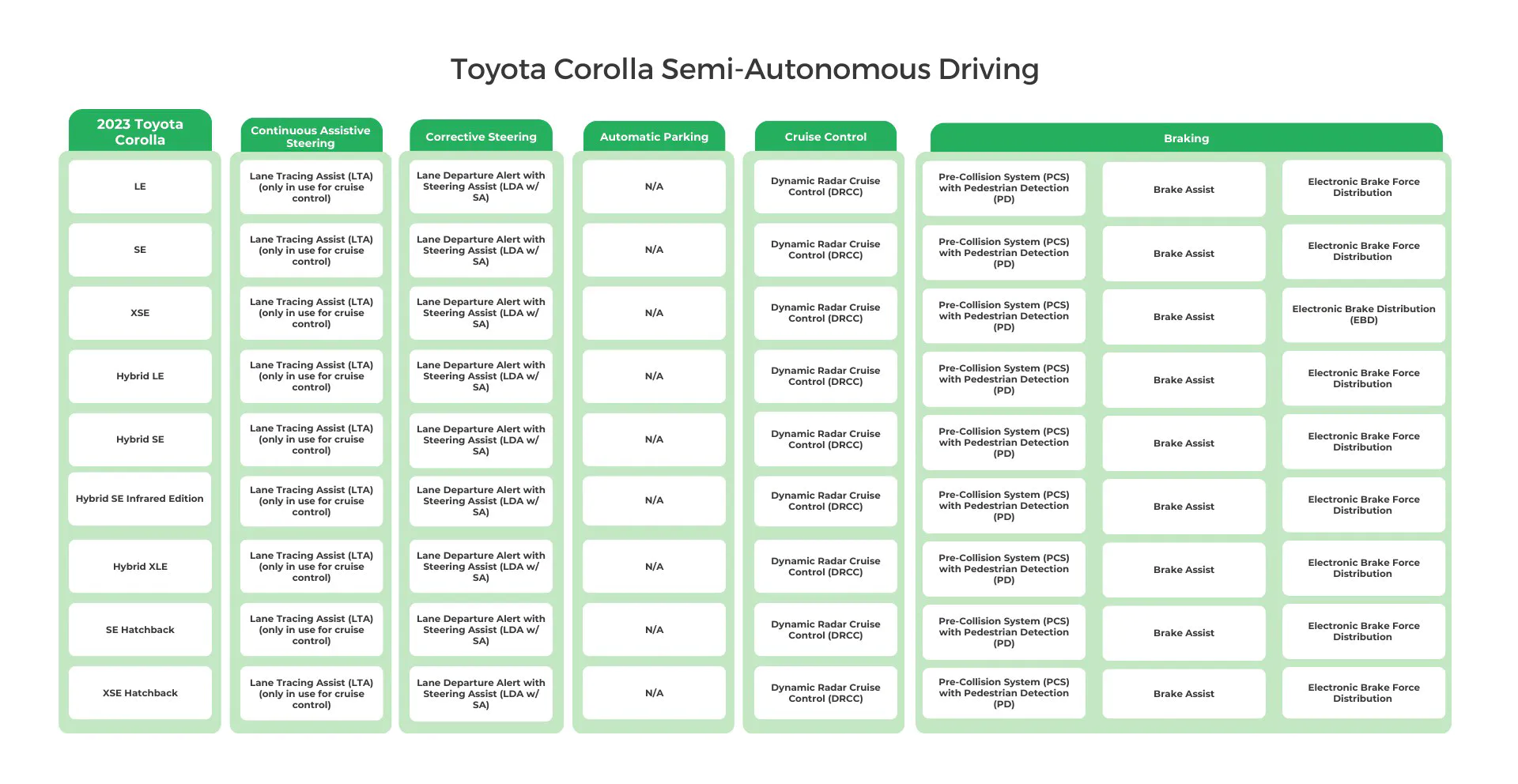
Driver Warning Systems & Telematics:
Although the Sentra and Corolla are on the lower end of the new car price scale, both vehicles are loaded with advanced driver assistance systems (ADAS). For instance, forward collision warning (FCW) and lane departure warning (LDW), which signal a driver about potential hazards, are standard with both vehicles.
I’m a big proponent of blind-spot monitoring (BSM) and rear cross-traffic alert (RCTA). If you’ve had a close call due to limited visibility (I have) or worse, you understand the value of this technology. This makes me call attention to Nissan for making BSM and RCTA standard on all Sentra trims. At the same time, Toyota only includes these features with more premium Corolla trims (available as an option on less expensive versions). Nissan cheapens the Sentra in some areas, but not with ADAS tech.
Secondary warning systems are a mixed bag. Only the Corolla gets traffic signs recognition (TSR), while a driver attention monitor is exclusive to the Sentra. Assuming you’re paying attention behind the wheel, neither feature is a must-have.
If ADAS technology appears like alphabet soup, check out an effort from AAA, Consumer Reports, J.D. Power, and other groups working to standardize the terminology for these systems.


Road Visibility Features:
Automatic high beams serve two functions: convenience for the driver and safety for oncoming traffic. It’s nice to see this feature standard on the Sentra and Corolla. LED headlights are also helpful, but it’s understandable why Nissan excludes this equipment from lower-end Sentras. The automaker has to keep costs down somehow. All Corolla editions come with LED headlights.
Backup cameras are required by federal law, so there’s no way to work around this mandate.
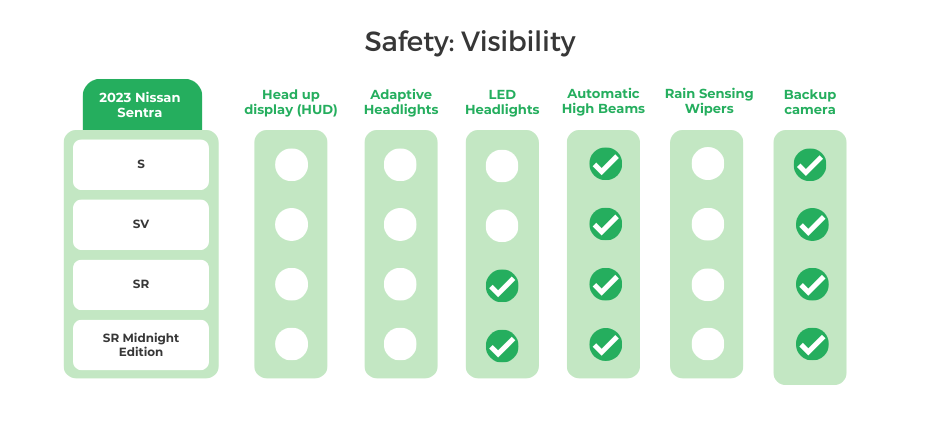
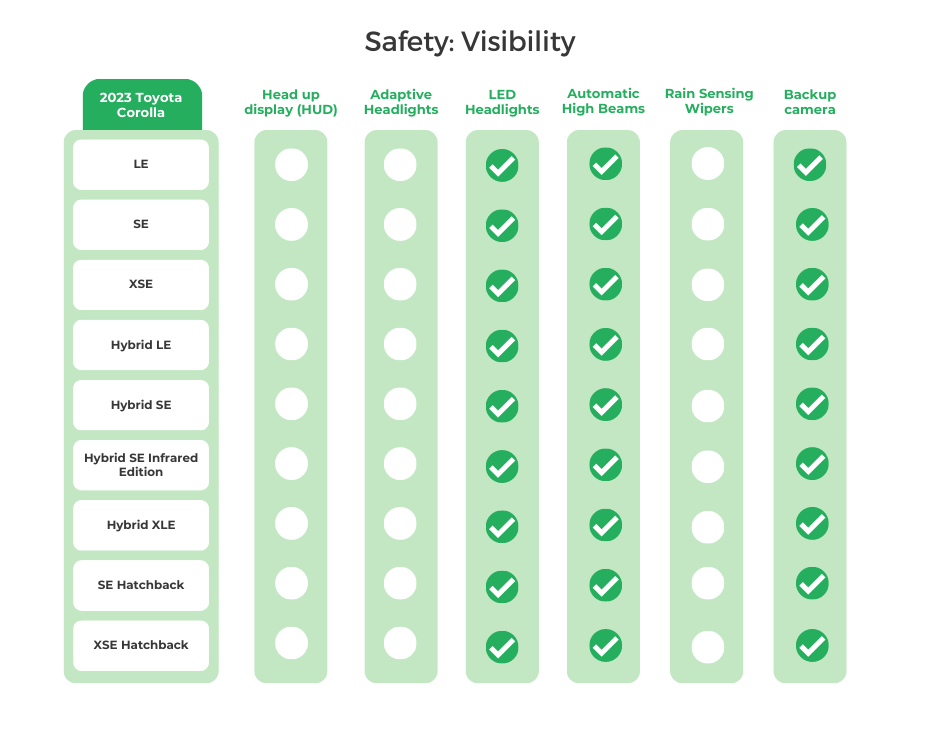
Interior:
Quick Take: The Sentra and Corolla share some interior features, while the Sentra’s larger cabin means more comfort, especially in the back seat.
Interior Features:
Buyers keen on easily connecting their phones to a car’s infotainment system will be comforted to know that Apple CarPlay and Android Auto are standard on all 2023 Sentras and Corollas.
Yet, this isn’t the case with heated front seats. Sentra buyers can upgrade the SV or SR trim with a heated seat option. In contrast, only the top Corolla trims come with this feature—there’s no option for the less expensive versions.
And speaking of heated seats, some automakers offer this feature through a subscription service. This hasn’t yet happened in the U.S., but in certain countries, BMW offered heated seats for a monthly fee. The advantage is you can shut off the service during warm months, but you’ll need to keep paying (or pay a one-time upfront fee) to activate the heated seats. Recently, BMW announced it was backing away from this practice. Moving forward, the automaker will only charge a subscription for software-based services (like upgraded navigation). Hardware-based features will be part of the vehicle’s initial purchase price.
One industry study shows mixed results for consumer acceptance of features on demand (FoD), with about one-fifth not even being aware of the concept.
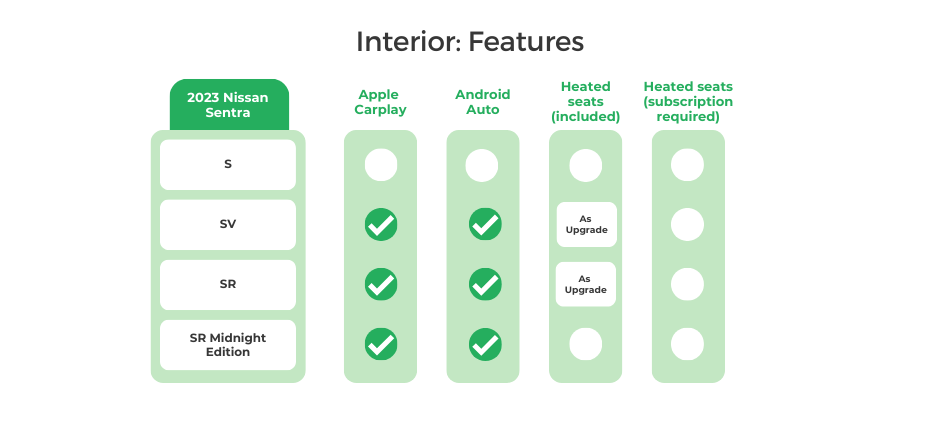
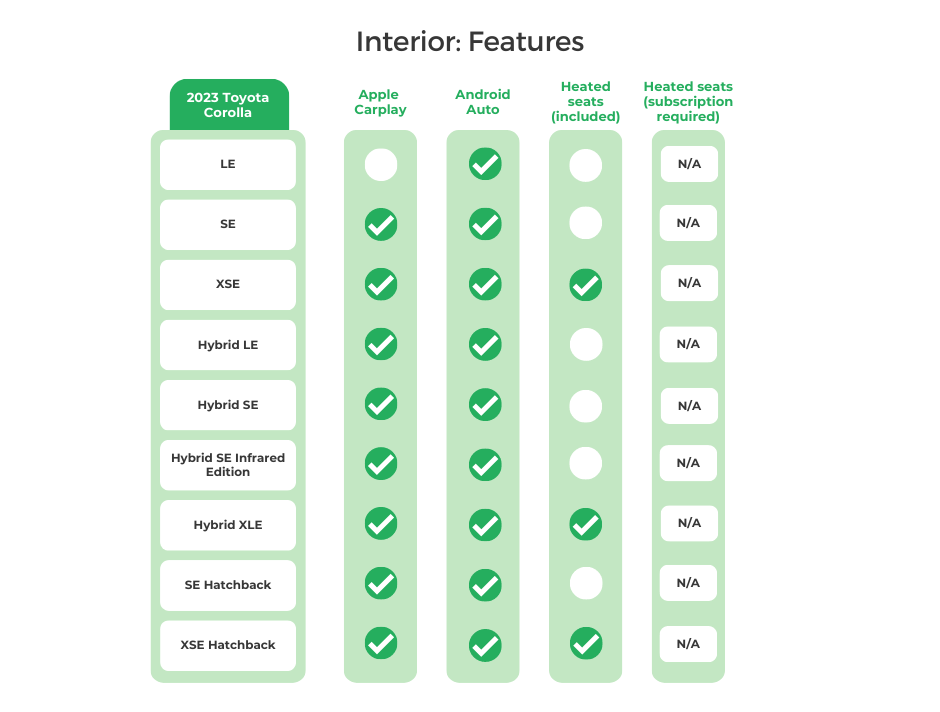
Interior Dimensions:
As mentioned, the Sentra and Corolla are classified as midsize cars. However, this Nissan has 96 cubic feet of passenger volume, compared to 88.6 cubic feet for the Corolla sedan.
This gap explains why the Sentra has better front legroom (44 inches versus 42 inches) but makes the back seat a mystery. The Corolla has a slight edge with 35 inches of rear legroom (the Sentra has 34.7 inches).
At the same time, greater front and rear shoulder room (by 1.5-2.4 inches) make the Sentra’s cabin more comfortable, especially when squeezing three people into the back seat. The findings are mixed when it comes to hip room. The Corolla is better in the front row, but not by much (half an inch). Yet, the Sentra is more generous in the back (53.3 inches of rear hip room compared to 51 inches for the Corolla sedan). Proving again that the Sentra will be more tolerable if all three second-row seats are occupied.
The Sentra’s 14.3 cubic-foot trunk is marginally larger than the Corolla sedan’s 13.1 cubic feet. But the difference could come in handy if you have to stuff a vehicle with groceries or luggage.
That said, the Corolla Hatchback’s 17.8 cubic-foot cargo area is more spacious and has greater versatility thanks to a rear liftgate and a folding second row. Otherwise, the Hatchback’s cabin is less accommodating.
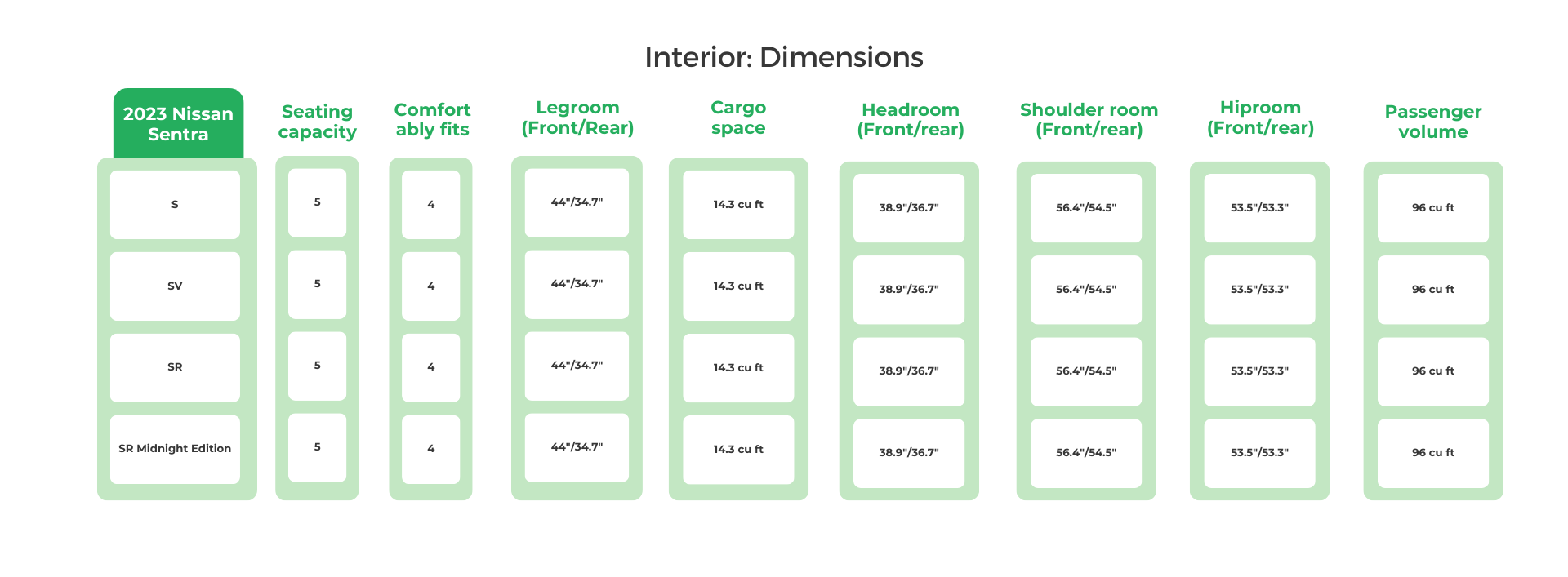
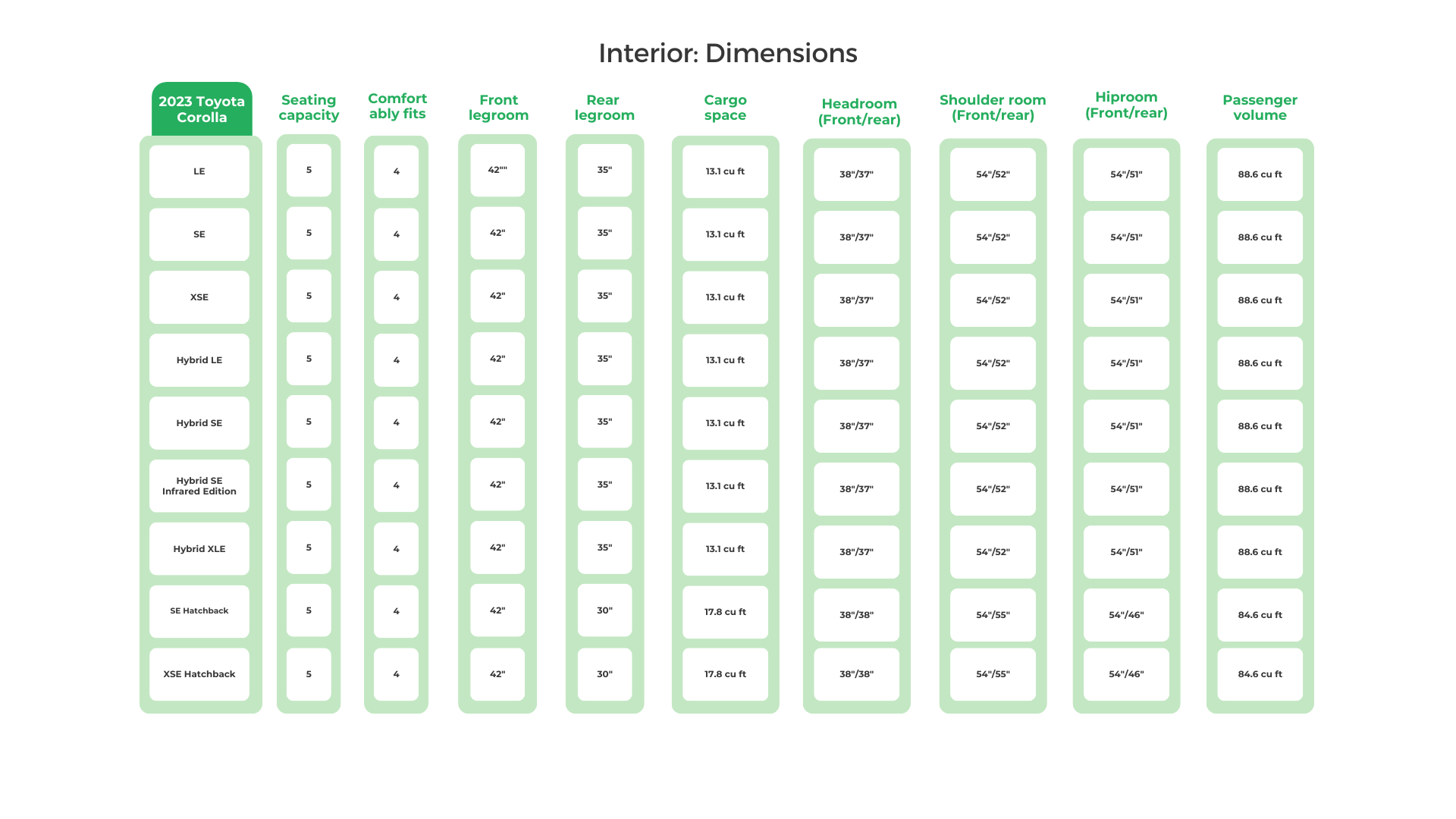
Exterior:
Quick Take: If you want a more exciting exterior shade, skip the Corolla sedan. The Sentra and Corolla Hatchback have broader color palettes.
Exterior Features:
Wheels may also be an afterthought for many car buyers. But wheel size can impact ride quality. Larger rims can translate into better traction and cornering but may result in a bumpier ride. Bigger wheels also offer better aesthetics by filling out the wheel wells more completely. This is why the higher the trim, the larger the wheel. Different materials (steel or alloy) and finishes also help separate the wheels among the various trim levels.
If monochromatic shades are your thing, then you’ll be fine with one of the white, black, gray, or silver exterior colors offered by Nissan and Sentra (it’s what most people get). Those looking for an individualistic expression will appreciate the punchier colors available with the Sentra.
Two-tone combinations (a black roof with Monarch Orange Metallic or Electric Blue Metallic) give this compact Nissan some character. The Corolla sedan does come in red or blue, but these colors are muted. However, the Corolla Hatchback dials up options with Inferno (orange), Finish Line Red, or Blue Crush Metallic, all of which can be accompanied by a black roof.
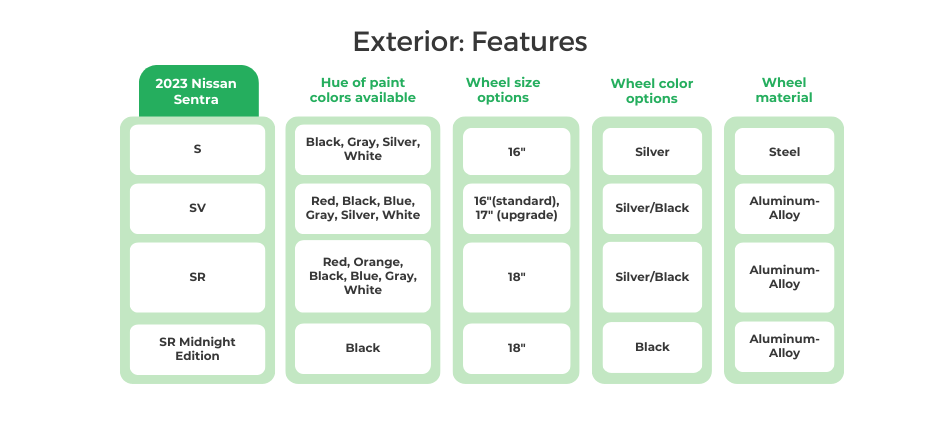
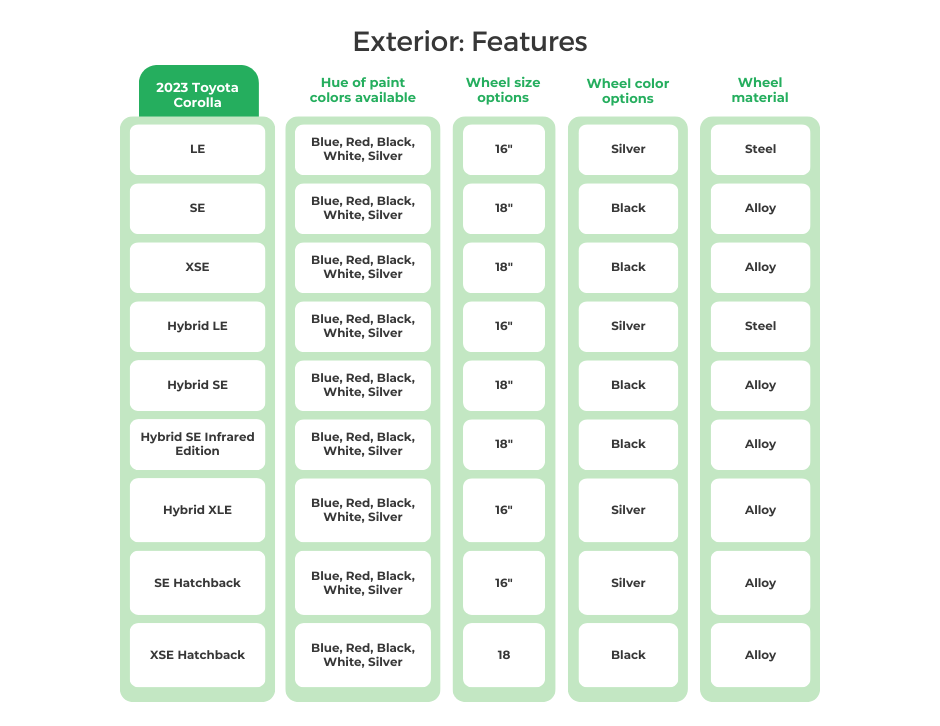
Exterior Dimensions:
Exterior size-wise, there’s not much separating the Sentra from the Corolla sedan. The difference in their respective lengths, heights, and wheelbases is less than an inch. The Sentra is 1.5 inches wider, which might make a difference in a very tight parking space, but this is unlikely to impact most owners. Spacious-conscious buyers needing the smallest option will want the 172-inch long Corolla Hatchback; it’s 10 inches shorter than the sedan edition or the Corolla.
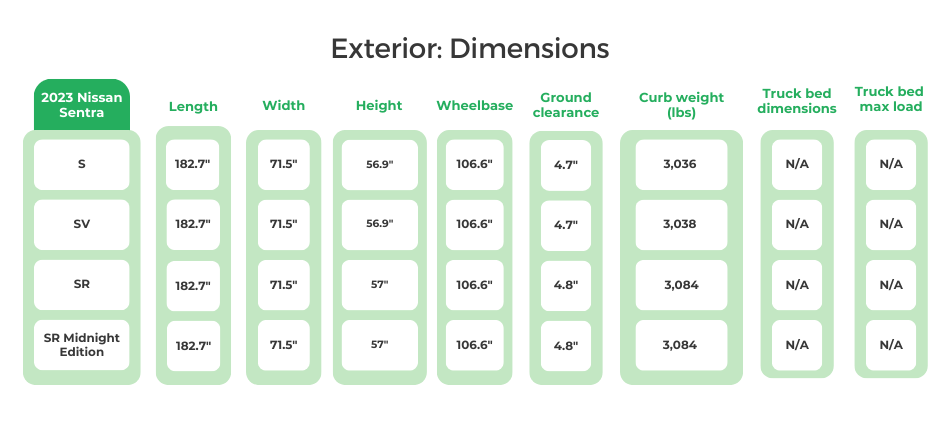
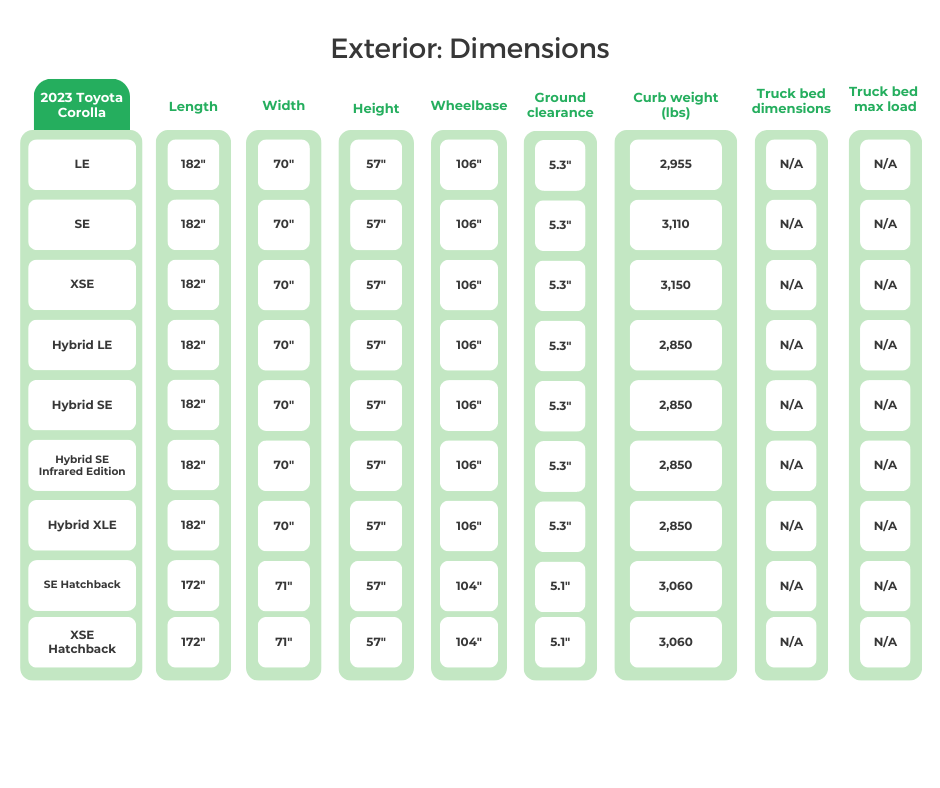
Warranty:
Quick Take: The Sentra and Corolla have similar primary warranties, but the Corolla gets two years of free maintenance.
The primary warranty coverage for the Sentra and Corolla overlaps. Both cars get a bumper-to-bumper factory warranty lasting three years or 36,000 miles. There are also matching powertrain warranties for five years or 60,000 miles.
Yet, there are some differences beyond these basics. Sentra owners get three years or 36,000 miles of roadside assistance (versus two years or 25,000 miles for the Corolla). However, Toyota includes free scheduled maintenance for two years or 24,000 miles. Nissan doesn’t, which can be justified by the Sentra’s lower upfront cost.
How much is two years of free maintenance worth on a Corolla? The automaker’s recommended service schedule calls for three oil changes over the initial two years. FIXD estimates that an oil change costs up to $120 when performed by a mechanic. So, new Corolla owners receive as much as $360 in value with Toyota’s complimentary maintenance program. The benefit could be worth even more when you include Toyota’s inspection and fluid top-off services.
| 2023 Nissan Sentra Factory Warranty Coverage: | 2023 Toyota Corolla Factory Warranty Coverage: | |
| Basic warranty: | 36 months/36,000 miles | 36 months/36,000 miles |
| Powertrain warranty: | 60 months/60,000 miles | 60 months/60,000 miles |
| Corrosion perforation warranty: | 60 months/unlimited miles | 60 months/unlimited miles |
| Air conditioning warranty: | 12 months/unlimited miles | 12 months/12,000 miles |
| Battery warranty: | 24 months (12-volt battery | 96 months/100,000 miles (hybrid battery) |
| Emissions warranty: | Federal: 36 month/36,000 miles (defect), 24 months/24,000 miles (performance)California: 36 months/50,000 miles (defect), 36 months/50,000 miles (performance) | Federal: 36 month/36,000 miles (defect), 24 months/24,000 miles (performance)California: 36 months/50,000 miles (performance) |
| Complimentary scheduled maintenance: | None | 24 months/25,000 miles |
| Roadside assistance coverage: | 36 months/36,000 miles | 24 months/25,000 miles |
| Total unique recalls: | 0 | 1 (recall no. 23V480000) |
Methodology
- Compare two vehicles, the Nissan Sentra and the Toyota Corolla, and provide a comprehensive analysis.
- Gather relevant information and data on both vehicles from reliable sources, such as manufacturer specifications, expert reviews, customer feedback, industry reports, and data sources like manufacturer websites, FIXD App, Kelley Blue Book, FuelEconomy.gov, and NHTSA.
- Collect data on various aspects, including performance, safety features, fuel efficiency, maintenance costs, reliability, owner satisfaction, and market value.
- Identify the key criteria that will be used to evaluate and compare the two vehicles.
- Ensure the criteria cover both objective factors (such as performance metrics, safety ratings, and fuel efficiency) and subjective factors (such as owner satisfaction, comfort, and features).
- Assess the performance of both vehicles based on factors such as acceleration, handling, braking, and overall driving experience.
- Compare engine options, horsepower, torque, transmission options, and any unique performance features.
- Examine the safety features and ratings of both vehicles.
- Evaluate crash test ratings, advanced driver assistance systems (ADAS), active and passive safety features, and any notable recalls or known issues related to safety.
- Consider both NHTSA safety ratings and IIHS awards for a comprehensive safety assessment.
- Analyze the fuel economy of both vehicles based on EPA mileage estimates.
- Compare their MPG ratings, average full-tank range, and any significant differences in fuel efficiency.
- Compare the features and technologies offered by both vehicles.
- Highlight any notable differences in terms of infotainment systems, connectivity options, driver assistance features, interior quality, and available upgrades.
- Summarize the findings of the comparison, highlighting the positives and negatives of each vehicle.
- Provide a fair and balanced recommendation based on the comparison, considering factors such as budget, personal preferences, specific needs of the buyer, and the comprehensive analysis conducted.
Sources:
- Fuel Economy: Mileage-per-gallon estimates according to the EPA MPG on Fueleconomy.gov.
- Safety Ratings: Crash test data collected and reported by NHTSA, as well as IIHS Award information, were collected for this article.
- Vehicle Prices/Features: Most or all information gathered on vehicle features was from the manufacturer’s website, in this case, nissanusa.com and toyota.com.

Dave Goldberg is an automotive journalist and lifelong car fanatic. He writes for numerous enthusiast and business outlets and is an ongoing contributor to HotCars.com, one of the most popular car culture websites. When he’s not writing or driving, Dave is either under a hood or asleep. His credentials include a BA in Journalism from The George Washington University.

